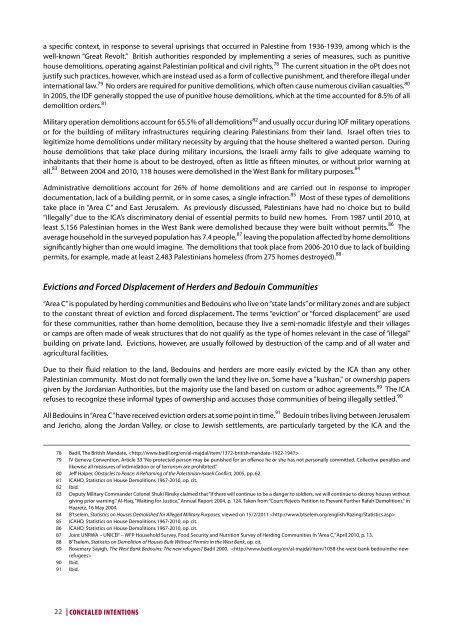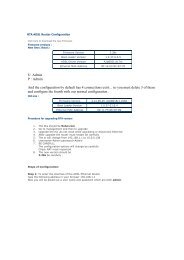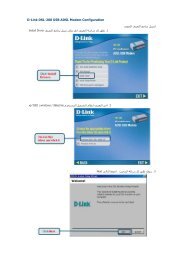Concealed Intentions- JLAC-.pdf
Concealed Intentions- JLAC-.pdf
Concealed Intentions- JLAC-.pdf
You also want an ePaper? Increase the reach of your titles
YUMPU automatically turns print PDFs into web optimized ePapers that Google loves.
a specific context, in response to several uprisings that occurred in Palestine from 1936-1939, among which is the<br />
well-known “Great Revolt.” British authorities responded by implementing a series of measures, such as punitive<br />
house demolitions, operating against Palestinian political and civil rights, 78 The current situation in the oPt does not<br />
justify such practices, however, which are instead used as a form of collective punishment, and therefore illegal under<br />
international law. 79 No orders are required for punitive demolitions, which often cause numerous civilian casualties. 80<br />
In 2005, the IDF generally stopped the use of punitive house demolitions, which at the time accounted for 8.5% of all<br />
demolition orders. 81<br />
Military operation demolitions account for 65.5% of all demolitions 82 and usually occur during IOF military operations<br />
or for the building of military infrastructures requiring clearing Palestinians from their land. Israel often tries to<br />
legitimize home demolitions under military necessity by arguing that the house sheltered a wanted person. During<br />
house demolitions that take place during military incursions, the Israeli army fails to give adequate warning to<br />
inhabitants that their home is about to be destroyed, often as little as fifteen minutes, or without prior warning at<br />
all. 83 Between 2004 and 2010, 118 houses were demolished in the West Bank for military purposes. 84<br />
Administrative demolitions account for 26% of home demolitions and are carried out in response to improper<br />
documentation, lack of a building permit, or in some cases, a single infraction. 85 Most of these types of demolitions<br />
take place in “Area C” and East Jerusalem. As previously discussed, Palestinians have had no choice but to build<br />
“illegally” due to the ICA’s discriminatory denial of essential permits to build new homes. From 1987 until 2010, at<br />
least 5,156 Palestinian homes in the West Bank were demolished because they were built without permits. 86 The<br />
average household in the surveyed population has 7.4 people, 87 leaving the population affected by home demolitions<br />
significantly higher than one would imagine. The demolitions that took place from 2006-2010 due to lack of building<br />
permits, for example, made at least 2,483 Palestinians homeless (from 275 homes destroyed). 88<br />
Evictions and Forced Displacement of Herders and Bedouin Communities<br />
“Area C” is populated by herding communities and Bedouins who live on “state lands” or military zones and are subject<br />
to the constant threat of eviction and forced displacement. The terms “eviction” or “forced displacement” are used<br />
for these communities, rather than home demolition, because they live a semi-nomadic lifestyle and their villages<br />
or camps are often made of weak structures that do not qualify as the type of homes relevant in the case of “illegal”<br />
building on private land. Evictions, however, are usually followed by destruction of the camp and of all water and<br />
agricultural facilities.<br />
Due to their fluid relation to the land, Bedouins and herders are more easily evicted by the ICA than any other<br />
Palestinian community. Most do not formally own the land they live on. Some have a "kushan," or ownership papers<br />
given by the Jordanian Authorities, but the majority use the land based on custom or adhoc agreements. 89 The ICA<br />
refuses to recognize these informal types of ownership and accuses those communities of being illegally settled. 90<br />
All Bedouins in “Area C” have received eviction orders at some point in time. 91 Bedouin tribes living between Jerusalem<br />
and Jericho, along the Jordan Valley, or close to Jewish settlements, are particularly targeted by the ICA and the<br />
78 Badil, The British Mandate, <br />
79 IV Geneva Convention, Article 33 “No protected person may be punished for an offence he or she has not personally committed. Collective penalties and<br />
likewise all measures of intimidation or of terrorism are prohibited.”<br />
80 Jeff Halper, Obstacles to Peace: A Reframing of the Palestinian-Israeli Conflict, 2005, pp. 62.<br />
81 ICAHD, Statistics on House Demolitions 1967-2010, op. cit.<br />
82 Ibid.<br />
83 Deputy Military Commander Colonel Shuki Rinsky claimed that “if there will continue to be a danger to soldiers, we will continue to destroy houses without<br />
giving prior warning.” Al-Haq, “Waiting for Justice,” Annual Report 2004, p. 124. Taken from “Court Rejects Petition to Prevent Further Rafah Demolitions,” in<br />
Haaretz, 16 May 2004.<br />
84 B’tselem, Statistics on Houses Demolished for Alleged Military Purposes, viewed on 15/2/2011 <br />
85 ICAHD, Statistics on House Demolitions 1967-2010, op. cit.<br />
86 ICAHD, Statistics on House Demolitions 1967-2010, op. cit.<br />
87 Joint UNRWA – UNICEF – WFP Household Survey, Food Security and Nutrition Survey of Herding Communities In “Area C,” April 2010, p. 13.<br />
88 B’Tselem, Statistics on Demolition of Houses Built Without Permits in the West Bank, op. cit.<br />
89 Rosemary Sayigh, The West Bank Bedouins: The new refugees Badil 2000. <br />
90 Ibid.<br />
91 Ibid.<br />
22





